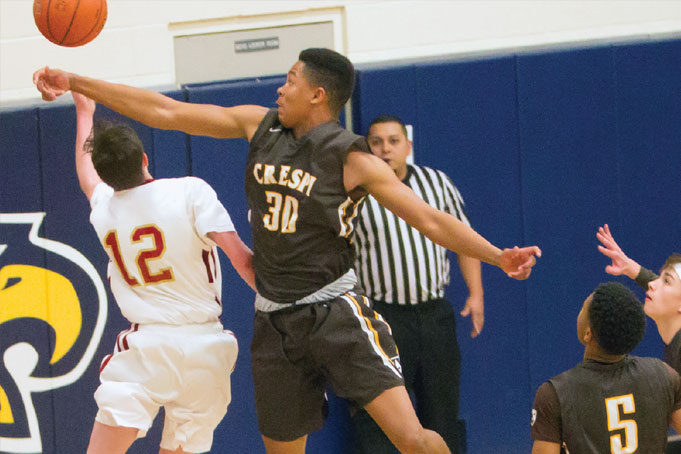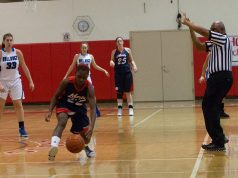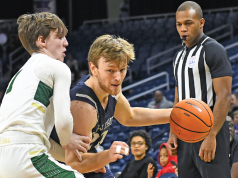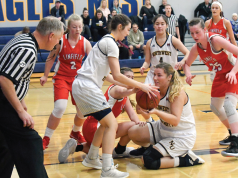The ballhandler dribbles up the court and, as the lead official, you are working to find the best possible position along the endline to officiate the play. Some of the basic factors to keep in mind include: the ball location, post players’ locations and active or engaging match-up situations.
Suddenly the post player sets an off-ball screen near the three-point line and the defense decides to switch. At this moment the lead official needs to recognize the unusual match-up. A post player is defending a guard and a guard is defending a post player. Typically, the offensive post player will attempt to use the new match-up to his or her advantage, especially near the basket.
The awareness for this particular match-up will improve your basketball IQ and ultimately will allow you to increase the accuracy of your decision making. Typically, the challenges presented in this type of mismatch are within the post play. Generally, the big-versus-small match-up will not occur on the perimeter because the defense has time to recover quickly. Additionally, when this match-up happens or starts from the perimeter, more times than not the play finishes with a drive to the basket before the mismatch can even develop.
However, when that same little-on-big mismatch is presented in the post area, there is a sense of urgency — regardless of offball or onball given the proximity to the basket. That proximity and sense of urgency leaves opponents wrestling to score via the disadvantage situation.
Any off-ball action typically begins to increase the intensity, so be ready and aware of the offense trying to create a mismatch with its post player(s). When waiting for the ball to arrive in this match-up, it may be too late to make the best decision on any contact.
There is not much opportunity for success with smaller opponents switched on larger opponents, especially near the basket. A lack of understanding puts officials reacting and behind the eight ball.
Here are five options officials must recognize when a big-small mismatch is presented to allow the most informed decision making.
1) Give up
The smaller defensive player knows there is not a good chance of success and does not want to risk a foul, so he or she will simply give up and let the bigger player score the basket without much pressure.
2) Foul
The outmatched opponent knows he or she will not be able to defend the offensive player successfully, so he or she has to attempt to foul.
3) Attempt to fool
When the defender knows he or she is beat, but does not want to just give up, the defender will attempt to fool the officials into bailing them out of their mismatched situation by flopping. The outmatched opponent hopes the officials will rule a foul and take the bait. In most cases, the player who flops ends up on his or her behind (sitting down) or might even throw the chin back. A true player-control foul has the defender ending up on his or her back.
4) Bull rush
When offensive players know they have a mismatch they will be licking their chops to score, but that does not mean the “big” can plow over or through the smaller disadvantaged opponents.
5) Over the top
When the bigger offensive opponent attempts to shoot over the top or fade away from the smaller opponent, officials should be less likely to rule illegal contact on the jump shot over the top. Avoid being fooled by the offensive player’s lack of aggression to take the easier shot at the basket or posting up the smaller player. Illegal contact that occurs with the shooter’s elbow or arm is a foul though.
Ensure your partners know when these big-small match-ups are occurring during a game. Use pregames, timeouts, quarter/period breaks, intermissions or quick dead balls to make your partners aware. Inform your crew that 15 and 25 is going to be a small-big match-up all game long. Or inform your partners that 10 and 42 seem to be paired up on switches and presenting some challenges for the crew, etc.
The beauty of discussing big-small match-ups is that they occur at every level and in most every game, no matter if you are working youth games or in the NBA.
Here are other differences to keep in mind with the little-on-big matchup.
Small versus big
You cannot let small beat up big. Sometimes we think the smaller player can do anything to the bigger player. Often we let the small player push the big player around. That forces the bigger player to get physical and often we call the second foul. Watch the small player, too.
Big versus small
Big cannot bully small, but small cannot beat up big, either. Just because the smaller player is physically outmatched does not mean the big player can muscle through. We must recognize the situation and then make the best judgment.
D bigger than O
When the defensive player is bigger than the offensive player, make sure the defender is vertical and does not step through the offensive player. The defender cannot bully the offensive player. Be patient as there could be a good verticality and legal block attempts. Recognize that the smaller offensive player may initiate contact, possibly even throwing themselves, into the bigger defender as a way to fool you into ruling a foul on the defender. Eliminate opportunities to be surprised by recognizing the big-small match-up so that you are not making a decision without all the information.
Rebounding finish
When the big-small situation goes throughout a shot attempt, there is bound to be contact earlier in the shot attempt, especially with the smaller player out farther from the basket than the big. That smaller player will push the offensive player with the hand or dislodge the opponent on the hip. In most situations, watch for the smaller player attempting to put their opponent under the basket before the ball comes off of the ring. One way you can tell that a slight dislodging of a bigger player is a foul is via the bigger player’s body accelerating in an abnormal way.
Differentiation
Another challenge of the big-small match-up is the displacement and dislodging that can occur favoring one side more than the other. With two opponents of equal size, the contact may lean more incidental than illegal. That tends to change quickly when there is a favorable situation for one player. The contact becomes more illegal than incidental because of the displacement and dislodging that occurs.
Tempers play into the situation as well
The officials need to be aware of what is going on and use feel for the situation. Take the situation where the small is now pestering the big because the small knows there is little chance for success unless the small is overly aggressive. Awareness to the potential for illegal contact is needed from the get-go. It is not fair to let all contact go just because one player is smaller than the other. Conversely, because a player is larger does not mean they must take the abuse either.
Whistle timing
There needs to be a difference with your whistle. On-ball action with little on big can be more patient than the off-ball scenario. With off-ball action you have to be immediate. The situation generally will only escalate and offball is more dangerous. Whereas with on-ball action there are more decisions to make and officials can let the play develop and see what happens. How does that play finish? The art of deciding when to whistle an on-ball action in the little-big match-up comes from experience.
What's Your Call? Leave a Comment:
Note: This article is archival in nature. Rules, interpretations, mechanics, philosophies and other information may or may not be correct for the current year.
This article is the copyright of ©Referee Enterprises, Inc., and may not be republished in whole or in part online, in print or in any capacity without expressed written permission from Referee. The article is made available for educational use by individuals.



















